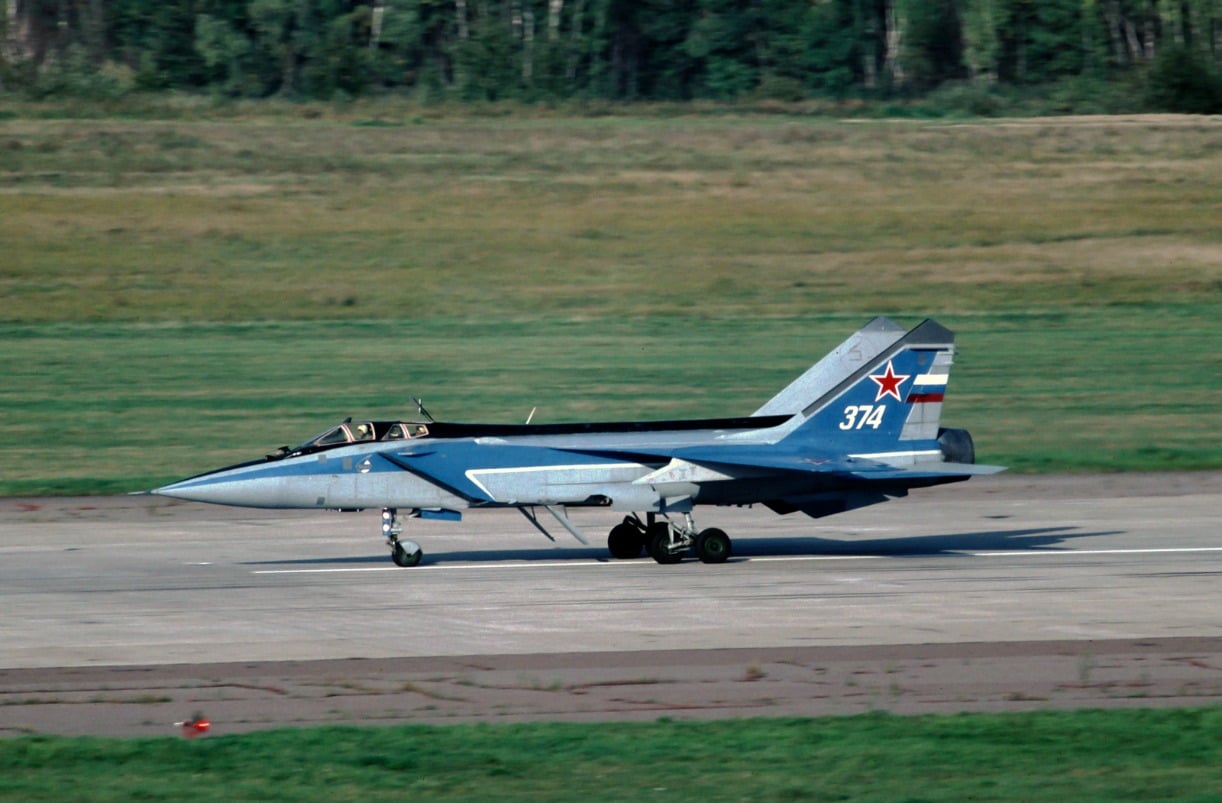Russia's MiG-31 Foxhound 'Fighter' Can Hit Mach 2.8
The Russian MiG-31 Foxhound, known for its remarkable speed of Mach 2.83, remains a critical asset in Russia's aerial fleet even after four decades. Upgrades on the MiG-31I variant, including air refueling, new avionics, and enhanced missile systems, extend its range and combat potential.
What You Need to Know: The Russian MiG-31 Foxhound, known for its remarkable speed of Mach 2.83, remains a critical asset in Russia's aerial fleet even after four decades. Upgrades on the MiG-31I variant, including air refueling, new avionics, and enhanced missile systems, extend its range and combat potential.

-Originally developed for high-speed interception rather than agility, the MiG-31 boasts advanced phased-array radar for long-range target tracking.
-While rumors persist about its Cold War encounters with U.S. SR-71 spy planes, the MiG-31 is slated to serve until at least 2030, solidifying its role in Russian and Kazakhstani defenses.
Russia’s MiG-31 Foxhound: How a Cold War Icon Still Holds Power
Described as the "fastest operational combat aircraft in the world," the Mikoyan MiG-31 (NATO reporting name Foxhound) has been in service for more than four decades, but it shows no signs of slowing down any time soon. The aircraft has received several key updates over the past 40 years, and it was reported months back that the latest variant, the MiG-31I, has been upgraded and received an air refueling system to increase the combat radius.
The MiG-31 is reported to be able to hit Mach 2.83, according to most analyses.
"MiG-31I fighters of the Russian long-range aviation received a possibility to refuel in the air and increased the combat engagement distance," a source in the Russian defense industry told state media outlet Tass, while another source added that the MiG-31I differs from the previous MiG-31K as it is outfitted with "different engines, avionics, and missiles."

Tass quoted the Izvestia daily military newspaper, which reported that the "MiG-31I will be able to refuel in the air. The fighter has electronic systems that increase the flight characteristics and capabilities. The jet is equipped with an electronic remote control system and onboard computers that automatically bring the jet into the required trajectory and fire a hypersonic missile at the calculated time."
Though an older platform, the upgrades should enable the MiG-31 to remain in service with the Russian Aerospace Forces for years to come.
The MiG-31 in the Crosshairs
Derived from the MiG-25 (NATO reporting name Foxbat) interceptor and equipped with state-of-the-art digital avionics, the MiG-31 long-range supersonic aircraft has maintained a certain mystique in the West, in part because there remains much speculation over all of its capabilities. Its reported airframe comprises 49 percent arc-welded nickel steel, 33 percent light metal alloy, 16 percent titanium, and two percent composites.
Unlike the MiG-25, it has two seats, with the rear occupied by a dedicated weapon systems officer.
The MiG-31 also was designed to work efficiently in all weather conditions, while its highly aerodynamic and streamlined body enabled it to fly at low altitudes with required supersonic speeds. It is equipped with efficient low-bypass-ratio turbofan engines, which allow an increase in combat range.

Though the MiG-31 was not developed for close combat or rapid turning, it was the first soviet fighter aircraft to have true look-down and shoot-down capability, while it could track multiple targets simultaneously at high altitudes.
Moreover, the MiG-31's Zaslon radar was the world's first phased-array unit, which had a range of 200 km. It could track 10 targets simultaneously, and control the engagement of 4 of them at once. Until 2001 – when the Japanese Mitsubishi F-2 with an advanced phased-array radar was adopted – the MiG-31 was the world's only serial fighter aircraft to be equipped with such a phased-array radar.
There have been rumors that during the late Cold War, a MiG-31 Foxhound may have been used to chase after the U.S. military's SR-71 Blackbird spy plane and reportedly locked on with its missiles, but as the American reconnaissance aircraft was never employed to overfly Soviet airspace. Whether the incidence occurred has remained a matter of conjecture at best.
Still in Service
The MiG-31 took its maiden flight in September 1975 and production of the aircraft began in 1979, while it formally entered service in 1982.
The MiG-31 was never exported by the Soviet Union, and a total of 519 were produced. Most have remained in service with the Russian Air Force, while some thirty are reported to be in service with the Kazakhstan Air Force.
However, Syria had reportedly ordered eight of the MiG-31E aircraft in 2007, while the order was suspended due to Israeli pressure along with a lack of Syrian funds. More recently, Turkish news media has reported that six of the aircraft may have been delivered for use by the Syrian Arab Air Force, but Russia has denied that it actually sold the aircraft to Syria.
The Russian Defense Ministry expects the MiG-31 to remain in service until 2030 or beyond.
Author Experience and Expertise: Peter Suciu, Defense Expert
Peter Suciu is a Michigan-based writer. He has contributed to more than four dozen magazines, newspapers, and websites with over 3,200 published pieces over a twenty-year career in journalism. He regularly writes about military hardware, firearms history, cybersecurity, politics, and international affairs. Peter is also a Contributing Writer for Forbes and Clearance Jobs. You can follow him on Twitter: @PeterSuciu.
You can email the author: [email protected].
All images are Creative Commons.


